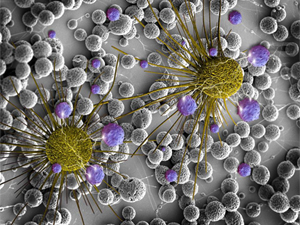



Date:21/06/16
 Someday, computers could help doctors diagnose diseases much faster than they can today. Researchers from Beth Israel Deaconess Medical Centre (BIDMC) and Harvard Medical School (HMS) have developed a way to train artificial intelligence to read and interpret pathology images.
Someday, computers could help doctors diagnose diseases much faster than they can today. Researchers from Beth Israel Deaconess Medical Centre (BIDMC) and Harvard Medical School (HMS) have developed a way to train artificial intelligence to read and interpret pathology images.
Andrew Beck from BIDMC explains that their "method is based on deep learning," which is commonly used to train AI to recognize speech, images and objects. They recently got the chance to prove just how effective their technique is during a competition at the annual International Symposium of Biomedical Imaging, where the AI was tasked to look for breast cancer in images of lymph nodes.
The team started training their machine by feeding it hundreds of slides marked to indicate which parts have cancerous cells and which have normal ones. They then identified which types of slides it was having the most trouble with and fed it more difficult samples. Using that method, the AI improved enough to be accurate 92 percent of the time and to win in two separate categories during the contest. It's still no match for human pathologists who are accurate 96 percent of the time, but it's clearly shown great promise.
Beck said what's truly exciting is that when they combined pathologists' analysis with their creation's, the results showed 99.5 percent accuracy. He added: "Our results in the ISBI competition show that what the computer is doing is genuinely intelligent and that the combination of human and computer interpretations will result in more precise and more clinically valuable diagnoses to guide treatment decisions."
AI is nearly as good as humans in detecting breast cancer
 Someday, computers could help doctors diagnose diseases much faster than they can today. Researchers from Beth Israel Deaconess Medical Centre (BIDMC) and Harvard Medical School (HMS) have developed a way to train artificial intelligence to read and interpret pathology images.
Someday, computers could help doctors diagnose diseases much faster than they can today. Researchers from Beth Israel Deaconess Medical Centre (BIDMC) and Harvard Medical School (HMS) have developed a way to train artificial intelligence to read and interpret pathology images.Andrew Beck from BIDMC explains that their "method is based on deep learning," which is commonly used to train AI to recognize speech, images and objects. They recently got the chance to prove just how effective their technique is during a competition at the annual International Symposium of Biomedical Imaging, where the AI was tasked to look for breast cancer in images of lymph nodes.
The team started training their machine by feeding it hundreds of slides marked to indicate which parts have cancerous cells and which have normal ones. They then identified which types of slides it was having the most trouble with and fed it more difficult samples. Using that method, the AI improved enough to be accurate 92 percent of the time and to win in two separate categories during the contest. It's still no match for human pathologists who are accurate 96 percent of the time, but it's clearly shown great promise.
Beck said what's truly exciting is that when they combined pathologists' analysis with their creation's, the results showed 99.5 percent accuracy. He added: "Our results in the ISBI competition show that what the computer is doing is genuinely intelligent and that the combination of human and computer interpretations will result in more precise and more clinically valuable diagnoses to guide treatment decisions."
Views: 497
©ictnews.az. All rights reserved.Similar news
- Azerbaijani project to monitor disease via mobile phones
- Innovative educational system to be improved under presidential decree
- NTRC prolongs license of two TV and radio organizations for 6 years
- Azerbaijan establishes e-registry for medicines
- Azerbaijani museum introduces e-guide
- Nar Mobile opens “Nar Dunyasi” sales and service center in Siyazan city
- International conference on custom electronic services held in Baku
- OIC secretary general to attend COMSTECH meeting in Baku
- Azerbaijan develops earthquake warning system
- New law to regulate transition to digital broadcasting in Azerbaijan
- Azerbaijani State Social Protection Fund introduces electronic digital signature
- Intellectual traffic management system in Baku to be commissioned in December
- Tax Ministry of Azerbaijan started receiving video-addresses
- World Bank recommends Azerbaijan to speed up e-service introduction in real estate
- Azerbaijan to shift to electronic registration of real estate





















